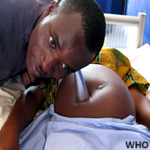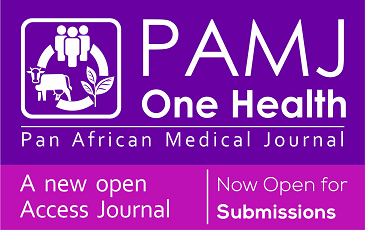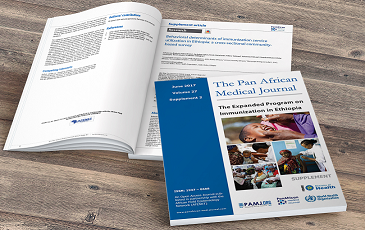Postpartum depression among mothers as seen in hospitals in Enugu, South-East Nigeria: an undocumented issue
Josephat Maduabuchi Chinawa, Odutola Isreal Odetunde, Ikenna Kingsaley Ndu, Euzebus Chinonye Ezugwu, Elias Chikee Aniwada, Awoere Tamunusiki Chinawa, Ugochukwu Ezenyirioha
Corresponding author: Josephat Maduabuchi Chinawa, College of Medicine, Department of pediatrics, University of Nigeria Teaching Hospital UNTH), Ituku- Ozalla, Enugu State, Nigeria 
Received: 20 Oct 2015 - Accepted: 03 Mar 2016 - Published: 14 Apr 2016
Domain: Maternal and child health
Keywords: Postpartum depression, prevalence, Enugu, mothers, associations
©Josephat Maduabuchi Chinawa et al. Pan African Medical Journal (ISSN: 1937-8688). This is an Open Access article distributed under the terms of the Creative Commons Attribution International 4.0 License (https://creativecommons.org/licenses/by/4.0/), which permits unrestricted use, distribution, and reproduction in any medium, provided the original work is properly cited.
Cite this article: Josephat Maduabuchi Chinawa et al. Postpartum depression among mothers as seen in hospitals in Enugu, South-East Nigeria: an undocumented issue. Pan African Medical Journal. 2016;23:180. [doi: 10.11604/pamj.2016.23.180.8244]
Available online at: https://www.panafrican-med-journal.com/content/article/23/180/full
Original article 
Postpartum depression among mothers as seen in hospitals in Enugu, South-East Nigeria: an undocumented issue
Postpartum depression among mothers as seen in hospitals in Enugu, South-East Nigeria: an undocumented issue
Josephat Maduabuchi Chinawa1,&, Odutola Isreal Odetunde1, Ikenna Kingsaley Ndu1, Euzebus Chinonye Ezugwu2, Elias Chikee Aniwada4, Awoere Tamunusiki Chinawa5, Ugochukwu Ezenyirioha6
1College of Medicine, Department of Pediatrics, University of Nigeria Teaching Hospital UNTH), Ituku- Ozalla, Enugu State, Nigeria, 2College of Medicine, Department of Obstetrics and Gynaecology, University of Nigeria Teaching Hospital UNTH), Ituku- Ozalla, Enugu State, Nigeria, 3College of Medicine, Department of Community Medicine, University of Nigeria Teaching Hospital UNTH), Ituku- Ozalla, Enugu State, Nigeria, 4College of Medicine, Department of Community Medicine, University of Nigeria Teaching Hospital UNTH), Ituku- Ozalla, Enugu State, Nigeria, 5College of Medicine, Department of Community Medicine, Enugu State University of Science and Technology, Enugu, 6College of Medicine, Department of Obstetrics and Gynaecology, Enugu State University of Science and Technology, Enugu
&Corresponding author
Josephat Maduabuchi Chinawa, College of Medicine, Department of Pediatrics, University
of Nigeria Teaching Hospital UNTH), Ituku- Ozalla, Enugu State, Nigeria
Introduction: postpartum depression is an uncommon and frequently undocumented issue that impacts negatively on maternal and child health.
Methods: the study was carried out among mothers who attended postpartum clinics from two teaching hospitals and three private hospitals all in Enugu metropolis. The instrument employed for data collection was a structured self-administered questionnaire developed from the Edinburgh Postnatal depression Scale. The families were assigned socio-economic classes (SEC) using the recommended method (modified) by Oyedeji. The objectives of this study was therefore aimed to highlight the pattern and prevalence of post-natal depression among mothers in Enugu, south east Nigeria.
Results: a total of 214 mothers attending postpartum clinics were recruited in this study. The prevalence of postpartum depression from this study is 22.9%. There are no significant association between socio-demographics of mother and depression, age (p= 0.556), educational level (p= 0.667), occupation (p=0.494), parity (p= 0.823) and mode of delivery (p= 0.760).
Conclusion: this study has shown that the prevalence of postpartum depression in Enugu, south east Nigeria is 22.9% which is comparable to that obtained in African continents. We noted no significant associations between socio-demographics of mother, age, educational level, occupation, parity and mode of delivery and depression.
The birth of a new baby is a major developmental transition in life that affects not only the woman, but also her baby and the family [1,2]. A common mental health problem during this period is Postpartum depression [1]. It is a serious public health concern and is associated with numerous medical and psychosocial problems in both mother and child [1]. While post partum depression poses a medical problem to the family, It is contrary to the condition called maternity blues. Postpartum depression meets the criteria of the Diagnostic and Statistical Manual of Mental Disorders, Fourth Edition (DSM-IV) for depression with incidence rate of 11 to 42% varying from one population to another [3,4].
Maternity blues a common, benign, transitory condition occurs in the first day after delivery with incidence ranging from 30 – 80 %. It normally starts 3-4 days after delivery and peaks on the fourth to fifth day [5]. Characteristic symptoms of maternity blues are crying, confusion, anxiety, mood changes, insomnia and dysphoria.
Postpartum depression is highly indicated when symptoms are severe and have lasted over two weeks. It is noted that in about 1 to 2 per 1,000, postpartum depression results in postpartum psychosis. In the United States, postpartum depression occurs in about 8 per 100,000 births [6,7]. Postpartum depression has also been seen as a temporary depression that afflicts about 15 percent of women following childbirth. It is more intense and long lasting than the “baby blues,” which affect as many as half of new mothers [7]. The cause of postpartum depression is not well known, however, it has been linked to a variety of endocrine root causes- especially postpartum thyroid dysfunction [8, 9]. Antenatal depression has also been considered to increase the risk for postnatal depression [9]. Maternal postpartum depression disturbs the attachment and bonding between mother and child and therefore adversely affects the infant´s development [10]. Some of these adverse effects include negative effects on cognitive development and social-emotional development of the child. These problems may persist and are unlikely to be responsive to intervention over time if the maternal depression remains untreated [11]. Postpartum depression also leads to increased costs of medical care, inappropriate medical care and discontinuation of breastfeeding [10].
The family unit is also affected by postnatal depression which may coexist with child abuse and neglect, marital discord, divorce and family violence [12]. Addressing maternal postpartum depression in a timely and proactive fashion is therefore essential to ensure optimal growth and development of the child [13]. The need for the study therefore cannot be downplayed especially its impact on health which had been mentioned hitherto. This study was therefore aimed to address the pattern and prevalence of post-natal depression among mothers in Enugu, south east Nigeria and associated factors.
Study area
The study was carried out among mothers who attended postpartum clinics from two teaching hospitals and three private hospitals all in Enugu metropolis. A simple random sampling was used to select the participants and University Of Nigeria Teaching Hospital, Ituku Ozalla and Enugu State University Teaching, are the major tertiary hospital used for the study.
Study population
The questionnaire was administered to the mothers who attended postnatal clinic within the first six weeks after delivery. Consent was obtained from the mothers after they had been told that their participation was completely voluntary in nature and that they could discontinue their involvement at any time. Enugu has a population of 3.5 million people according to the national population census [12]. Anonymity and confidentiality of responses were also conveyed. Mothers who gave consent and who had no history of any psychiatric illness were included in this study while mothers who were on any antipsychotic drugs or who had psychiatric disorders were excluded.
Case selection
A total of 214 mothers attending postpartum clinics and who fulfilled the inclusion criteria were consecutively recruited in this study .
Sample size estimation
The minimum sample size used in this study was calculated using the formular [13]. N = Z2P (I - P)/D2 Where Z = 1.96 i.e. the level of significance, P = Prevalence Maternal depression (0.14) from previous study [14]. D = Tolerable error (0.05). Using the above formula, the minimum sample size is 197. 10% attrition rate was considered, this brought the final value to 214.
Study procedure
The instrument employed for data collection was a structured self-administered questionnaire developed from the Edinburgh Postnatal depression Scale, a Screening Test for postpartum depression [15]. The questionnaire contains 10 items with each item bearing 5 sub questions. These questions are graded. Response categories were scored 0, 1, 2, and 3 according to increased severity of the symptom. The total score was calculated by adding the scores for each of the 10 items. Score between 15 and 30 suggest depression. The families were assigned socio-economic classes (SEC) using the recommended method (modified) by Oyedeji [16].
Ethical considerations
ethical clearance for the study was obtained from the Research and Ethical Committee of the Enugu State University of science and technology. A written consent was obtained from the parents/caregivers of the subjects and controls after explaining to them, in detail, the objectives of the study.
Table 1 shows that majority of mothers were aged 30 years and below (65.9%). Their mean age was 29.52 ± 4.44. About 70% had tertiary education. They were mainly Civil or public servants (36%). Almost equal proportion was multiparous and primiparous (49.1% and 48.1% respectively). Highest proportion (63.1%) delivered by vaginal means. Table 2 shows that 40.2% were less than 4 weeks (Neonates) and 54.7% from 4 weeks to 52 weeks. Most mothers had baby boy (57.5%).
Forty nine (49) mothers out of two hundred and fourteen had post partum depression .This gives a prevalence rate of 22.9%. Table 3 shows that there were no significant association between socio-demographics of mother and depression, age (p= 0.556), educational level (p= 0.667) , occupation (p=0.494 ), parity (p= 0.823 ) and mode of delivery (p= 0.760). Table 4 shows that there were no significant association between socio-demographics of baby and depression. age (p= 0.521 ) and sex (p= 0.546).
This study has shown that postpartum depression does exist in our environment. The prevalence of 22.9% obtained in this is much lower than the prevalence of 43% obtained by Nakku [14] et al in Uganda but similar to the prevalence estimates of 18.3% seen in African as a region by Sawyer [17] et al. Findings from developed countries on the African continent such as South African have found prevalence rates of depressive symptoms of 34.7% [18]. It is known that postpartum depression is the most common complication of childbearing affecting some women which poses a public health problem.
In general, Studies report prevalence rates among women from 5% to 25%. However, among men, who are new fathers, the incidence of postpartum depression has been estimated to be between 1% and 25.5% [19]. The variation in prevalence obtained in this study from that obtained in other studies could be due to Methodological and geographical differences. We noted no association between maternal age, social class, parity and gender of baby with postnatal depression. A Study has also shown no increased risk of depression in older first-time mothers due to their age [20].
Arianna [21] et al in their study also noted no association between depression and parity but noted an association with the onset of depression within 6 weeks in women with mood disorders (Bipolar depression). They concluded that primiparity is also associated with postpartum psychosis/mania. Psychosocial factors and biological differences between first and subsequent pregnancies may play a role and are factors to consider in further studies [22].
We noted no association between postpartum depression and mode of delivery. Other studies also noted no association between postpartum depression and mode of delivery [22,23]. Lucic [24] et al did a systematic review of five studies and noted no association between postpartum depression and mode of delivery.
Our findings on the association between age of the baby and post natal depression is refuted by Heron et al who reported an increase incidence of depression as the age of the child increases. He noted that the incidence of depression at 3 and 12 months post partum for mothers was similar to that reported by other authors who used the same cut-off score and scale of measurement [25]. We noted from this study that more than 70% of mothers have tertiary education and 60% are working class. This shows increase rate of female education and women empowerment in this part of the country. However, these two strong variables pose little or no influence on post partum depression.
This study has shown that the prevalence of postpartum depression in Enugu, south east Nigeria is 22.9% which is comparable to that obtained in African continents. We noted no significant associations between socio-demographics of mother, age, educational level, occupation, parity and mode of delivery and depression. Limitation: conducting a study in the community would avoid, at least to some degree, selection bias by including those who do not attend postnatal care. Furthermore, a multi centre study would presumably increase the sample size and thus the power to find associations.
What is known about this topic
- Maternal postpartum depression distorts the attachment and bonding between mother and the new born and therefore adversely affects the infant's development.
- Evaluation of post partum depression among mothers attending post natal clinic in south east Nigeria is a very vital issue often under reported in this part of the world.
- The prevalence of post partum depression in sub-Saharan Africa has also increased due to apparent lack of interest by researchers.
What this study adds
- This study therefore highlighted the pattern and prevalence of post-natal depression among mothers in Enugu, south east Nigeria and advocate for the early identification and referral of affected mothers for appropriate intervention.
- It also raise an alarm that not all maternal blues are really maternal blues, they should be further evaluated.
The authors declare no competing interests.
CJM, NIK, OOI had primary responsibility for protocol development, patient screening, enrolment, outcome assessment, preliminary data analysis, and writing of the paper. ECA performed the final data analyses. UE, ATA and EUS participated in the development of the protocol and analytical framework for the study and contributed to writing of the paper. All authors have read and agreed to the final version of this manuscript and equally contributed to its content and to the management of the case.
We acknowledge the nurses in the postnatal clinics of the four hospitals, their contributions are priceless.
Table 1: socio-demographics of mother
Table 2: socio-demographics of baby
Table 3: associations between socio-demographics of mother and depression
Table 4: associations between socio-demographics of baby and depression
- Barber JS, East PL. Home and parenting resources available to siblings depending on their birth intention status. Child Development. 2009 May; 80(3):921-939. PubMed | Google Scholar
- Bartell SS. The birth of a second child: A unique impact on the family system. International Journal of Childbirth Education. 2004 Feb;19 (1):4-7. PubMed | Google Scholar
- Evins GG, Theofrastous JP, Galvin SL. Postpartum depression: a comparison of screening and routine clinical evaluation. Am J Obstet Gynecol. 2000 May;182(5):1080-1082. PubMed | Google Scholar
- O'Connor TG, Heron J, Glover V, Alspac Study Team. Antenatal anxiety predicts child behavioral/emotional problems independently of postnatal depression. J Am Acad Child Adolesc Psychiat.2002 Dec; 41(12):1470-1477. PubMed | Google Scholar
- Postpartum Depression Postpartum Depression – Epidemiological and ... - DiVA Portal. Obtainable from http://www.diva-portal.org/smash/get/diva2:21141/FULLTEXT01.pdf. Accessed on 1/06/2015
- Seyfried and Marcus . Postpartum mood disorders. International Review of Psychiatry. 2003 July; 15(3):231-242. PubMed | Google Scholar
- Pearlstein T, Howard M, Salisbury A, Zlotnick C. Postpartum depression. Am J Obstet Gynecol. 2009 April; 200(4):357-64. PubMed | Google Scholar
- Kent GN, Stuckey BGA, Allen JR, Lambert T, Gee V. Postpartum thyroid dysfunction: clinical assessment and relationship to psychiatric morbidity. Clin Endocrinol. 1999;51(9):429-438. PubMed | Google Scholar
- Barca MF, Knobel M, Tomimiri E, Cardia MS, Medeiros-Neto G. Prevalence and characteristics of postpartum thyroid dysfunction in Sao Paulo Brazil. Clin Endocrinol. 2000 July;53(1):21-31. PubMed | Google Scholar
- Earls MF. Committee on Psychosocial Aspects of Child and Family Health American Academy of Pediatrics: Incorporating recognition and management of perinatal and postpartum depression into pediatric practice. Pediatrics. 2010 Oct;126(5):1032-1039. PubMed | Google Scholar
- Marian FE. Incorporating Recognition and Management of Perinatal and Postpartum Depression Into Pediatric Practice. Pediatrics. 2010;126:1032-1039. PubMed | Google Scholar
- McLennan JD, Kotelchuck M. Parental prevention practices for young children in the context of maternal depression. Pediatrics. 2000 May;105(5):1090-1095. PubMed | Google Scholar
- Araoye MO. Research methodology with statistics for health and social sciences. 1st ed. Ilorin, Nathadox Publishers 2004; 115-120. PubMed | Google Scholar
- O'Hara MW, Swain AM. Rates and risk of postpartum depression-A meta-analysis. Int Rev Psychiatry. 1996 Aug;8(6):37-54. PubMed | Google Scholar
- Trapolini T, McMahon CA, Ungerer JA. The effect of maternal depression and marital adjustment on young children's internalizing and externalizing behavior problems. Child Care Health Dev. 2007 Nov;33(8):794-803. PubMed | Google Scholar
- Nakku JEM, Nakasi G, Mirembe F. Postpartum major depression at six weeks in primary health care: prevalence and associated factors. African Health Sciences. 2006Oct; 6(8):207-214. PubMed | Google Scholar
- Sawyer A, Ayers S, Smith H. Pre and postnatal psychological well-being in Africa: a systematic review. Journal of Affective Disorders. 20 Aug;123(1-3):17-29. PubMed | Google Scholar
- Cooper PJ, Tomlinson K, Swartz L, Woolgar M, Murray L, Molteno C. Postpartum depression and mother-infant relationship in a South African peri-urban settlement. British Journal of Psychiatry. 1999 Jan;175(1):554-558. PubMed | Google Scholar
- Paulson, James F. "Focusing on depression in expectant and new fathers: prenatal and postpartum depression not limited to mothers". Psychiatry Times. 2010 Feb; 27(2):1-3. PubMed | Google Scholar
- Postpartum Depression: Are Older Mothers More at Risk? | Morris ... Obtainable from http://www.morrispsych.com/postpartum-depression-are-older-mothers-more-at-risk/.Accessed on 1/06/2015
- Arianna Di Florio, Lisa Jones, Liz Forty, Katherine Gordon-Smith, Emma Robertson Blackmore, Jess Heron, Nick Craddock, Ian Jones. Mood disorders and parity - A clue to the aetiology of the postpartum trigger. Journal of affective dosordre. 2014 Jan;152(100):334-339. PubMed | Google Scholar
- Chaaya M, Campbell OM, El Kak F, Shaar D, Harb H, Kaddour A. “Postpartum depression: prevalence and determinants in Lebanon”. Archives of Women's Mental Health. 2002 Oct;5(2):65-72. PubMed | Google Scholar
- Gonidakis F, Rabavilas AD, Varsou E, Kreatsas G, Christodoulou GN. “A 6-month study of postpartum depression and related factors in Athens Greece”. Comprehensive Psychiatry. 2008 May;49(3) 49275-282. PubMed | Google Scholar
- Carter FA, Frampton CMA, Mulder RT. Cesarean section and postpartum depression: a review of the evidence examining the link. Psychosomatic Medicine. 2006 Mar-april;68(2):321-330. PubMed | Google Scholar
- Heron J, O'Connor TG, Evans J, Golding J, Glover V,ALSPAC Study Team. The course of anxiety and depression through pregnancy and the postpartum in a community sample. J Affect Disord. 2004 May;80(1):65-73. PubMed | Google Scholar











